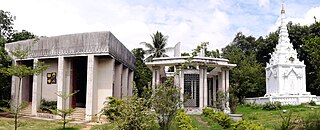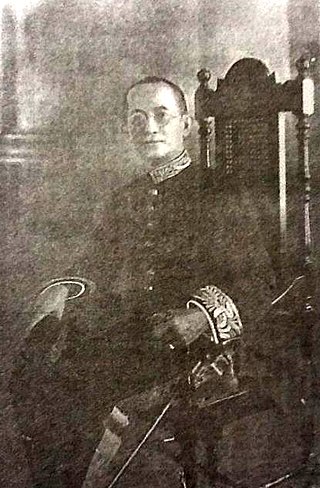Related Research Articles

Khin Nyunt is a retired Burmese army general widely recognized for his influential role in shaping Myanmar's political dynamics. Serving as the Chief of Intelligence and Prime Minister of Myanmar from 25 August 2003 to 18 October 2004, he played a crucial part in the nation's history. During his tenure, Khin Nyunt oversaw significant developments in Myanmar's intelligence and apparatus and government policies. He was instrumental in implementing reforms aimed at modernizing intelligence operations and promoting national security interests. However his leadership faced challenges, and he was eventually removed from power in 2004 amid political reshuffles within the ruling military junta. Despite his removal from office, Khin Nyunt's legacy continued to be debated, with some viewing him as a reformist figure and others critiquing his approach to governance.
Sir John Guy Rutledge, KC was a British barrister and colonial judge and official in Lower Burma.

Thibaw Min, also Thebaw, was the last king of the Konbaung dynasty of Burma (Myanmar) and also the last Burmese monarch in the country's history. His reign ended when the Royal Burmese armed forces were defeated by the forces of the British Empire in the Third Anglo-Burmese War, on 29 November 1885, prior to its official annexation on 1 January 1886.

The University of Yangon, located in Kamayut, Yangon, is the oldest university in Myanmar's modern education system and the best known university in Myanmar. The university offers mainly undergraduate and postgraduate degrees programs in liberal arts, sciences and law. Full-time bachelor's degrees were not offered at the university's main campus after the student protests of 1996. The bachelor's degree was re-offered from 2014 on. Today degrees in Political Science are offered to undergraduate students, as well as postgraduate diplomas in areas such as social work and geology.

Saya Zawgyi was a distinguished and leading Burmese poet, author, literary historian, critic, scholar and academic. He is regarded as the greatest of Myanmar's poets. His name, Zawgyi, refers to a mythical wizard from Burmese mythology. He was one of the leaders of the Hkit san movement in Burmese literature searching for a new style and content before the Second World War, along with Theippan Maung Wa, Nwe Soe and Min Thu Wun. His first hkit san poetry, Padauk pan, was published in Hantha Kyemon pamphlet.
Dr Maung Maung was a well-known writer and legal scholar in Myanmar, who served as the seventh president of Burma from 19 August 1988 to 18 September 1988.

Sir Ba U, was a Burmese politician and lawyer. He served as Chief Justice of the Supreme Court of Burma from 1948 to 1952, and the second president of Burma from 16 March 1952 to 13 March 1957.

The Church of the Province of Myanmar in Asia is a member church of the Anglican Communion. The province comprises the entire country of Myanmar. The current archbishop of Myanmar and bishop of Yangon is Stephen Than Myint Oo.
Pe Khin was a Burmese diplomat. He was one of the main negotiators at the Panglong Conference in Burma and the architect of the historical Panglong Agreement.
Khin Maung (Bank) (ခင်မောင် ; 1910 – 20 December 1983) was a Burmese painter and sponsor of the arts who was influential in the art world of Mandalay, Myanmar. More importantly, however, he was the major force for the development of a modernistic movement in painting in Burma, which began in the early 1960s.
Myo Min was a Burmese academic, journalist and writer, who wrote under the pen names of Nwe Soe, U Myo Min and Myint Win. He was one of the founders of the Khit-San Sarpay movement, the first modern literary movement in the history of Burmese literature. He was the longtime Professor of English at Rangoon University and later at Yangon Institute of Education. He also served in several academic and research organizations, including the Burma Historical Commission, the Burma Research Society, and the Burma Translation Society. For his services to the country, he was awarded the honorary titles of Wunna Kyawhtin in 1954 and Thiri Pyanchi in 1961 by the government.
Maung Htaw Lay was Magistrate of Moulmein (Mawlamyine) from 1838 to 1853 during the early British colonial period of Myanmar (Burma), and governor of Dala from 1805 to 1827 during the Konbaung period. Prior to his defection to the British in 1827, he had been a Royal Burmese Army commander, and had fought in the First Anglo-Burmese War (1824–26). At Moulmein, Htaw Lay became one of the most senior indigenous officials in the colonial government. He moved to Yangon (Rangoon) in 1853 after the British annexation of Lower Burma. He successfully used his influence with the colonial government to stop the occupation forces' pillaging of Buddhist shrines around Yangon, and with the help of his son-in-law Maung Khaing, spent the rest of his life restoring the Shwedagon Pagoda.

The Kandawmin Garden Mausolea comprise a mausoleum complex in Yangon, Myanmar. The site contains four mausolea of Burmese national figures and is located near the southern gate of Shwedagon Pagoda. The successive Burmese military governments feared that the mausolea might become a meeting place for democracy activists and they fell into a state of neglect. The former military regime omitted them from the Yangon City Heritage List because they are symbols of national liberty and considered a threat to its status and power.

Sir Joseph Augustus Maung Gyi was a Burmese barrister, judge, politician and administrator who served as the Acting Governor of British Burma during the tenure of Charles Alexander Innes, who was away on sick leave in the United Kingdom. He was the first Burmese governor during the British colonial period. At various other times during the colonial era he served as Minister of Agriculture, Excise and Forestry, of Home Affairs, and as Minister for Transferred Subjects.

Thiri Pawara Atula Tilawka Maha Yazeinda Adhipati Yadana Dewi, commonly known as Setkya Dewi or Sekkya Dewi, was Queen of the Konbaung Kingdom of Burma from 26 March 1853 to 12 November 1876 as the chief queen of Mindon Min. Born to Tharrawaddy Min and his wife, she held the position of the Tabindaing Princess during her father's reign. Being renowned for her knowledge of modern science and astrology, Setkya Dewi was popular with the British, who described her as a well-educated woman, and visitors would often bring her gifts related to her astrological interests.

Thiri Pyanchi Ba ThanFRCS FACS FICS was a Burmese medical surgeon, educator and administrator. The first Burmese police surgeon in British Burma, Ba Than founded and ran the main hospital in Rangoon (Yangon) as well as the wartime medical and nursing schools during the Japanese occupation of the country (1942–1945). After the country's independence in 1948, Ba Than served several terms as dean and rector of the main medical universities in Rangoon and Mandalay until two months before his death in 1971.
Thiri Pyanchi Min Sein was a Burmese physician, educator and administrator. The first Burmese dean of the Faculty of Medicine of Rangoon University in British Burma, Min Sein was one of the small group of senior physicians that rebuilt and expanded the country's medical education system from the ground up after the country's independence in 1948. He served as the dean of the medical school four times between 1947 and 1959, and led the Burma Medical Research Institute, the Burma Medical Association and the Burma Olympic Committee.
This is a list of chief justices of the Union of Myanmar and its predecessor offices.

Paw Thame (1948–2014) was a Burmese-American painter. He was one of the leaders of the modernist art movement in Burma during the 1970s and early 1980s. Paw Thame, Win Pe, Kin Maung Yin and Bagyi Aung Soe were friends at the Peacock Gallery exchanging modernist ideas and concepts, alternatively supporting one another and locked in rivalry. They built on the foundations laid by early Burmese modernists Aung Khin and Kin Maung (Bank). Now recognized as the giants of Burmese modern art, Yangon society in the 1970s disparaged them--"modern art" was literally translated as "psychopathic art" or "crazy art".

Taingda Mingyi U Pho was a Burmese official of the royal courts of King Mindon and King Thibaw during the Konbaung dynasty. He became the most powerful official at King Thibaw's court and held several key positions, including Minister of the Interior, Minister of Defense, and Senior Minister of the Hluttaw. Taingda was seen as an opponent of Kinwun Mingyi U Kaung and the leader of the conservative faction that advocated for war with the British.
References
- ↑ Maung Maung (1957). Burma in the Family of Nations (2 ed.). Djambatan. p. 90.
- ↑ Burmese Encyclopedia (in Burmese). Vol. 2. Sarpay Beikman. 1955. p. 307.
- ↑ Kin Thida Oung (2008). A Burmese Matriarch. ISBN 978-1-4357-3785-3.